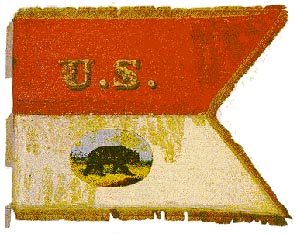

California's role in the Civil War has never gained much recognition; regrettably, the men from this state who fought to preserve the Union have been almost forgotten - until now.
They considered themselves Californians,
but nearly all had come to the Golden State from east of the Mississippi.
When war broke out, many of those settlers recruited regiments,
many destined to fight in the East. As a result, few of the Union
Army troops from California were ever properly honored. Those
valiant California Volunteers literally became "unknown soldiers"
and the important roles they played in the Civil War were largely
forgotten.
As one of the newest states in the Union, California was represented in quasi-official status among the Eastern volunteer regiments. As an example, members of the California 100 and Battalion became a part of the 2nd Massachusetts Cavalry. They were recruited and formed in California prior to moving east to join the battle. This group alone fought in 51 battles, skirmishes and campaigns from Gettysburg to Appomattox. Today, the California 100's war-torn colors and guidon can be seen hanging in the California State Capitol.
Colonel Roderic Matheson, a native of New York, lived in California. He recruited a regiment, while in the East, composed of men from the West Coast. When this original First California was formed, it was not credited to any state, but was treated as a Regular Army organization. Mustered into Federal service at Fort Schuyler, New York, it was thereafter sent to pull picket and scouting duty at Fort Monroe, New York. Matheson's First California took part in nine major battles and campaigns. Although he called his unit The First California Regiment, its heroic struggles were noted in battle records as the accomplishments of the 32nd Regiment of New York Volunteers.
Colonel Matheson 's war ended with his death during the fighting at Campton Pass, Maryland. He was later buried at his California residence with full military honors. When the terms of enlistment expired for the men of the regiment, they were honorably mustered out on June 9, 1863.
Another individual who personified the spirit of California during the Civil War was Edward D. Baker. A former California resident, Baker was a good friend of President Abraham Lincoln. Lincoln commissioned Baker as a Colonel of the Volunteers. Newly appointed, Colonel Baker was to form a volunteer regiment and thereafter build his unit into a full brigade. Those regiments were to be credited to California. Further, the money to pull together this volunteer brigade was to be provided by the State of California.
Baker's First California volunteers participated in the Battles of Bull Run, Antietam and Fredericksburg; by war's end in 1865 had fought in 17 major battles and campaigns.
As to Colonel Baker, he was posthumously promoted to Major General, U.S. Volunteers after being killed at the Battle of Ball's Bluff on October 21, 1861.
The Brigade; with the exception of a few officers and three companies, was largely from Pennsylvania. With the untimely death of General Baker, the interest of California in the Brigade ended. Pennsylvania then claimed the unit as one of its own. Thereafter it was known as the Pennsylvania Brigade.
The Californians, and others in the Brigade, participated in one of the most crucial clashes between the Union and Confederate Armies. These brave men, who received little credit in their home state, withstood the brunt of confederate General Pickett's Charge during the Battle of Gettysburg. This action is considered the linchpin of the conflict that helped the Union Army prevail at Gettysburg and ultimately win the Civil War.
Another group of largely "unsung" heroes fought to keep order and preserve the Union west of St. Joseph, Missouri. Over 17,000 California troops kept the Oregon Overland and Santa Fe Trails open and protected the western portion of the Trans-Continental Telegraph Lines.
These troopers also secured the routes that sent over five million dollars, monthly, of California gold east to shore-up the Union bonds, which financed the war.
While fighting Indians and limited skirmishes with Confederate troops, their presence helped prevent reinvasion and occupation of the Southwest U.S. Territory. While the Civil War ended for most in 1865, these Californians remained on duty until 1867, when Regular Army forces finally relieved them.
Per-capita, California provided more troops
than any other state in the Union. The first Californian to receive
the nations highest military award, The Medal of Honor, was Captain
Henry H. Crocker for heroic action at Cedar Creek, Virginia. Crocker
was a member of the California 100.